This post may contain affiliate sales links. Please read my disclosure policy.
Learn to make the perfect all-butter pie crust with this recipe! The simple method produces a flaky pie crust and can be done with a food processor or by hand! You’ll never need another pie crust recipe!
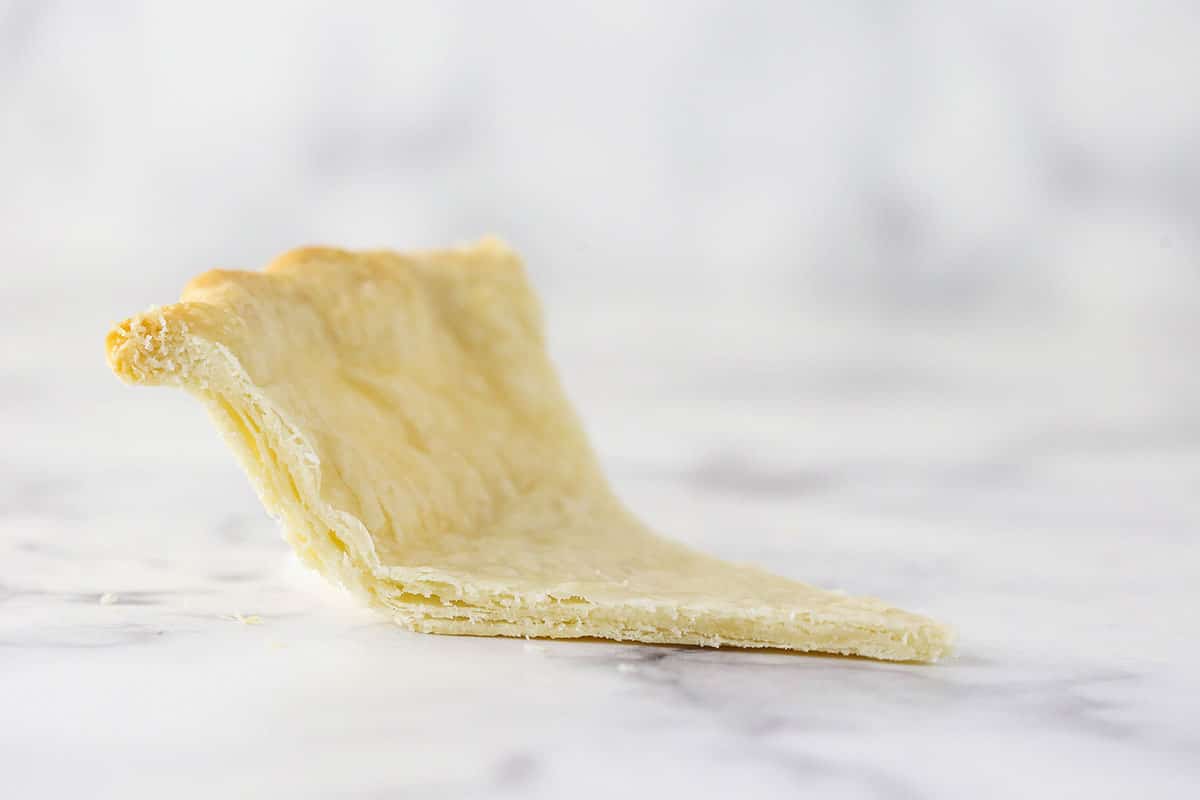
Homemade Flaky Pie Crust
There’s something very satisfying about making things from scratch. Especially when you understand why you’re doing what you’re doing and how it all works. I truly enjoy learning all the things related to what I’m baking and I hope you do too. I want to share it all with you so that when you make this pie crust, you get it just right.
Pies are pretty much a guarantee this time of year. I have several pie recipes that are PERFECT for Thanksgiving, including my Pumpkin Pie and Salted Honey Pie, which make appearances at my house every year. Seriously, if you haven’t tried that Salted Honey Pie, you are missing out. If you think you won’t like it because of the honey, think again. It is easily in my top 10 recipes on this entire site. I love it that much.
But this post is about crust, so let me get back to that. I’ve often used refrigerated pie crust for ease and saving time because the holidays are crazy. However there’s something to be said for making the entire pie from scratch and the great flavor it gives. Plus, pie crust can be made a couple days ahead and refrigerated (so can the pie, usually!), so why not go ahead and make it from scratch?!
This pie crust also has an excellent method that works great every time. I’m a fan.
Too Much Gluten Formation is Bad
This is the cake in most baked goods, and pie crust is no exception. Some gluten is good and gives the crust structure, but when too much gluten forms, things can turn out tough. So we want less gluten formation for a tender and flakier pie crust.
So one thing that you often see is recipes that use vodka in the pie crust. Cooks Illustrated started this and the theory here is that vodka doesn’t promote gluten formation, helping give you a tender crust. You’d end up with half vodka and half water in the recipe. Personally I don’t feel like it’s necessary, but if you have a tendency to overwork things, it could be helpful.
Add Flour in Two Parts
That said, another way to help reduce gluten formation that is actually used in the method for this pie crust is to add the flour to the butter in two parts. You add the first half of the flour and fully mix that with the butter. The fat in the butter will fully coat every bit of flour, helping it to not absorb water and prevent the formation of too much gluten. Then, when you add the rest of the flour, some gluten is formed, but not too much. Perfection!
The other thing I like about this method has to do with the size of the pieces of butter in the pie dough. If you have too many big chunks of butter throughout your dough, you’re not getting it as evenly dispersed so that it creates even more flakes. This method of combining the butter with half of the four first allows the butter a chance to blend into smaller pieces without running the risk of forming too much gluten in the process. Overall, you get smaller bits of butter and fewer big pieces, which I believe leads to a flakier crust as well.
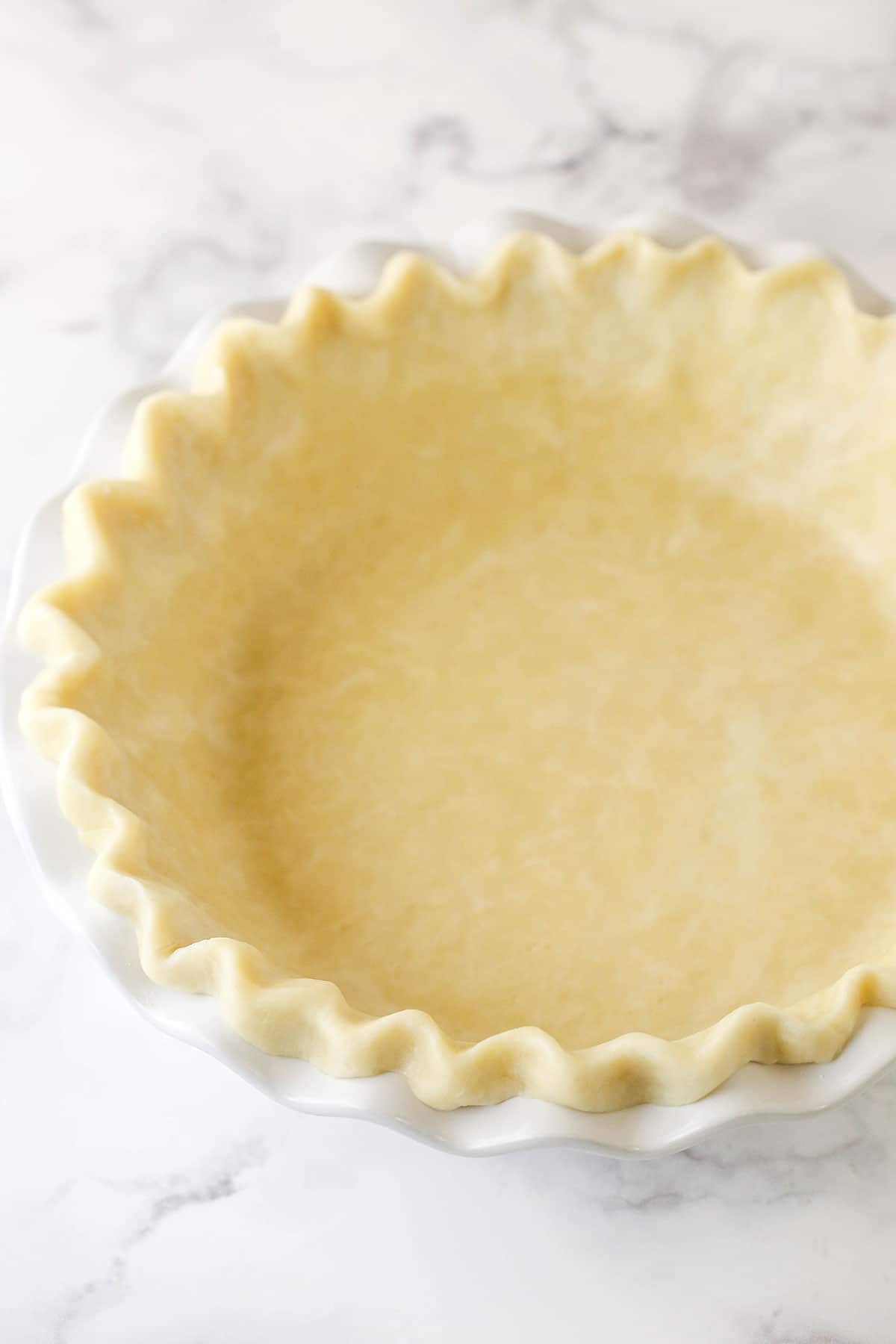
Pie Crust Ingredients
You only need four ingredients for this homemade pie crust.
- All Purpose Flour: Pie crust is a great time to use a high quality flour if you want to invest in one, but any flour should work just fine.
- Salt: For flavor. Never leave it out.
- Butter: Also another time to use a great quality butter. Be sure it’s cold, cold, cold. You can even pop it in the freezer to be sure it’s super cold.
- Ice Water: Again, cold, cold, cold. We want to keep our butter from getting warm as we make our dough. If it melts, you won’t get little pockets of butter that lead to flaky layers.
Butter versus Shortening
This crust uses all butter. This may be highly debated and I’m sure there are some serious lovers of shortening out there – I’m certainly not opposed to it. But upon testing both options, I personally preferred the taste of an all-butter crust. Shortening has a higher melting point than butter, which can help in creating flakiness, but again I go back to the method. With the method of this pie crust, things like vodka and shortening aren’t necessary to having a flaky crust.
Cold Butter For Flaky Pie Crust
Keeping the butter as cold as possible ensures flaky layers in your pie crust. If it melts in the dough before baking, you lose the little lumps of butter that create the flakes. As the crust bakes, the butter melts and the steam from the butter’s water content separates the crust into layers. So you need layers of cold butter that melt to create layer in your pie crust. Those layers are the flakiness we want.
How to Make Pie Crust
I use a food processor because I find it easiest and it saves my arm, but you can do this method by hand as well.
1. Pulse Flour and Salt: Add 1 1/2 cups of the flour and the salt to a large food processor (or bowl, if not use food processor) and pulse together 2 to 3 times.
2. Add Butter: Scatter the cubed, cold butter over the flour and process until a crumbly dough forms, about 15 seconds. You’ll have some larger and smaller pieces, but all the flour should be coated. No dry flour should remain.
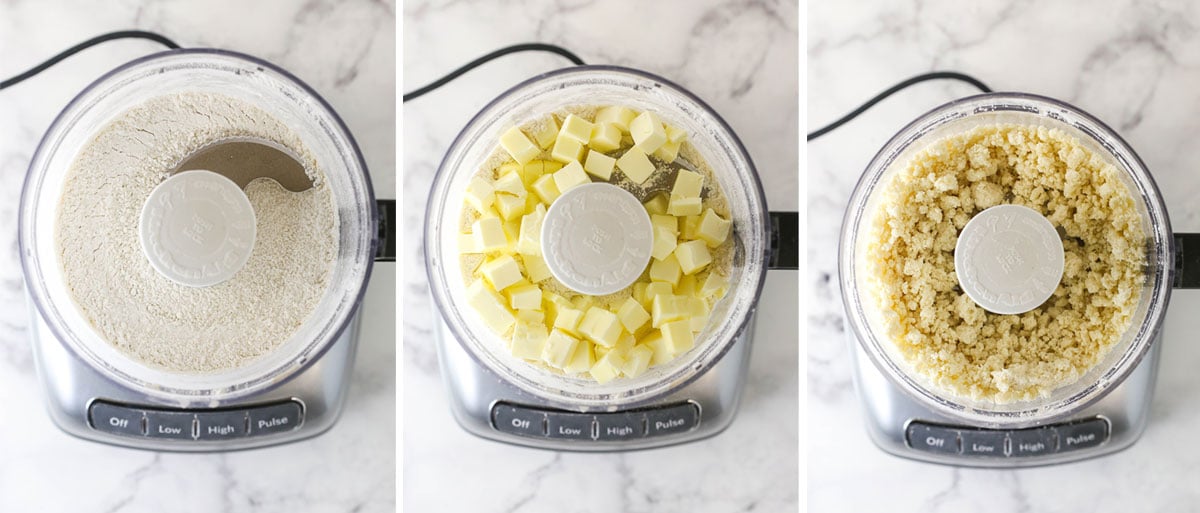
3. Add Remaining Flour: Add the remaining cup of flour and pulse a few times until everything is evenly distributed. The doughy pieces should break up and it should look sandy. There shouldn’t be a bunch of big pieces remaining. A few are fine, but it should be mostly evenly distributed.
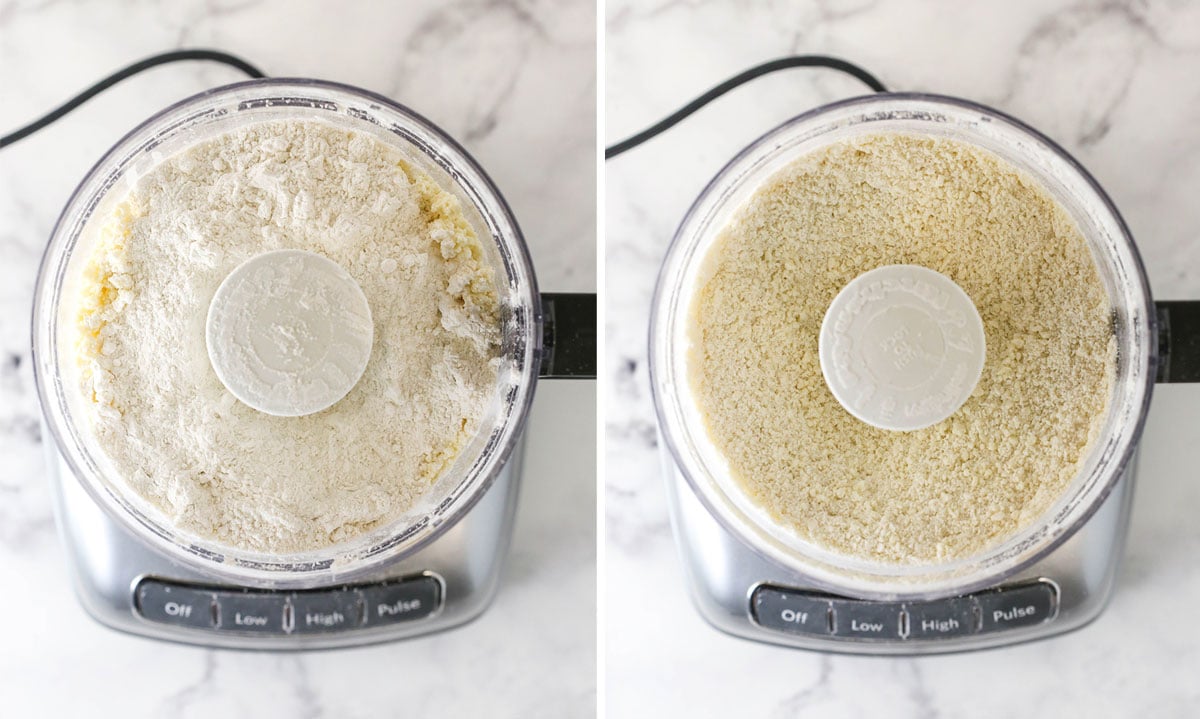
4. Add Water: Move the mixture to a mixing bowl and add 4 tablespoons of the ice water. Start with 4 tablespoons and add from there. Using a rubber spatula, gently fold everything together. The crumbs should begin to form larger clusters. If you pinch some of the dough and it holds together nicely, it’s ready. If the dough falls apart, add 1-2 more tablespoons of water and continue to press until dough comes together.
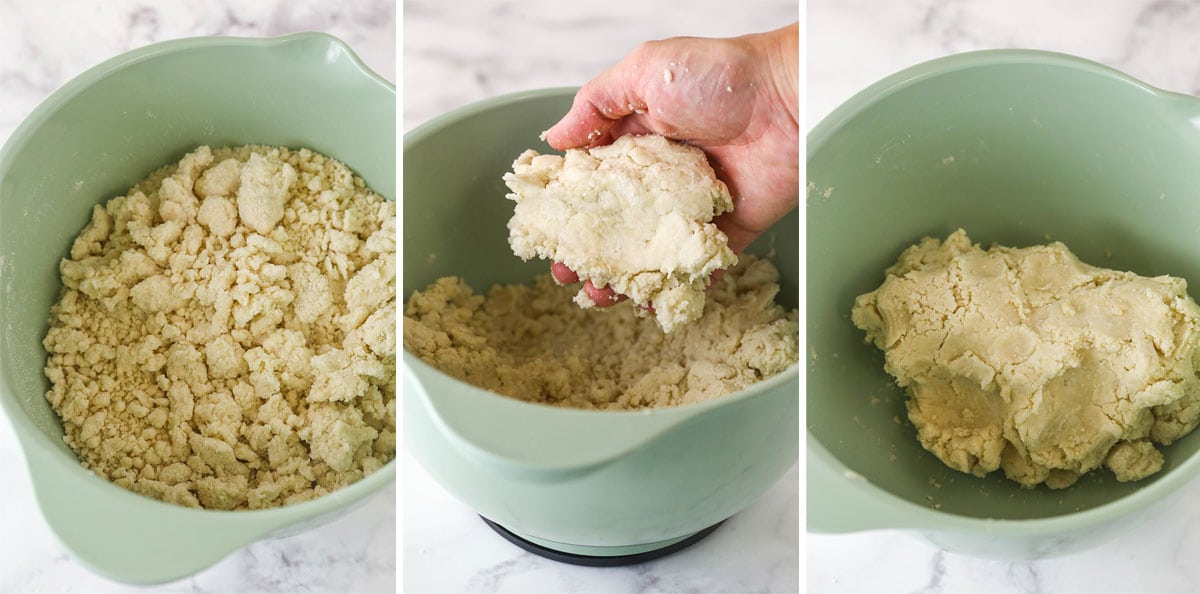
5. Refrigerate The Dough: Pour the dough out onto a piece of parchment paper and work just enough for it to come together and form a ball. Cut the ball in half and shape each into a disc. You should be able to see flecks of butter! Wrap each disc in plastic wrap and refrigerate for at least an hour or up to 2 days.
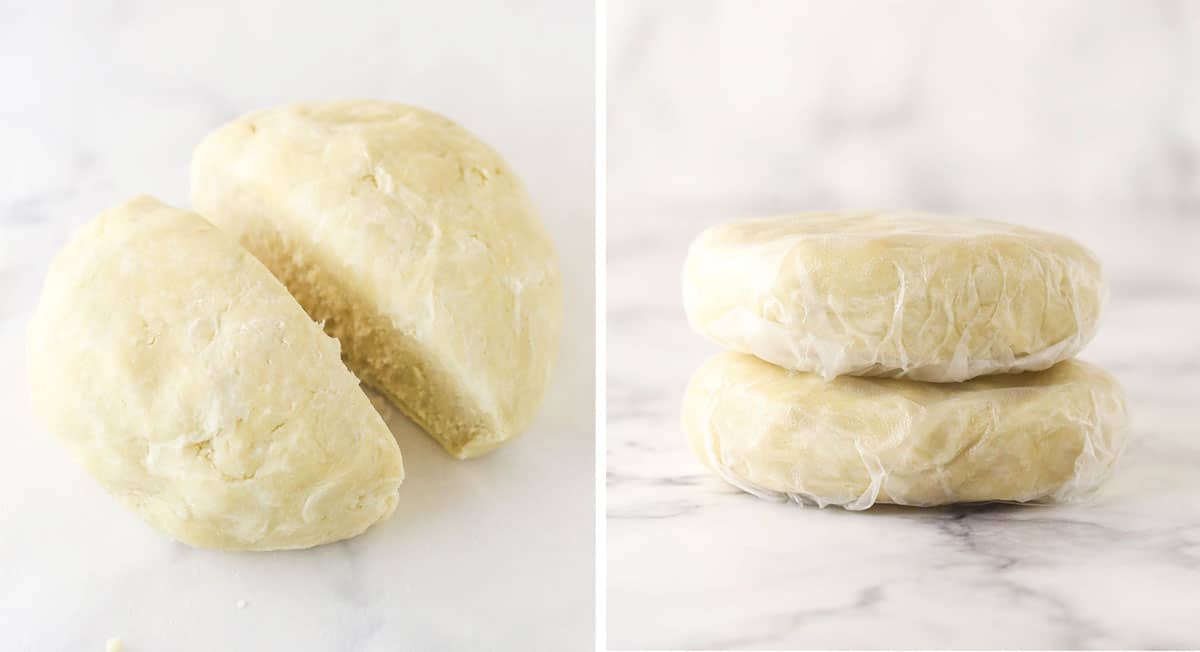
How to Roll Out Pie Crust
I am a big fan of using parchment paper when rolling out pie crust. It’s non-stick and eliminates the need for extra flour that makes for a messy work surface. Plus, the parchment paper makes it MUCH easier to transfer the rolled out pie crust to your pie plate. Put the dough between two pieces of parchment paper for rolling – one on top and one on bottom.
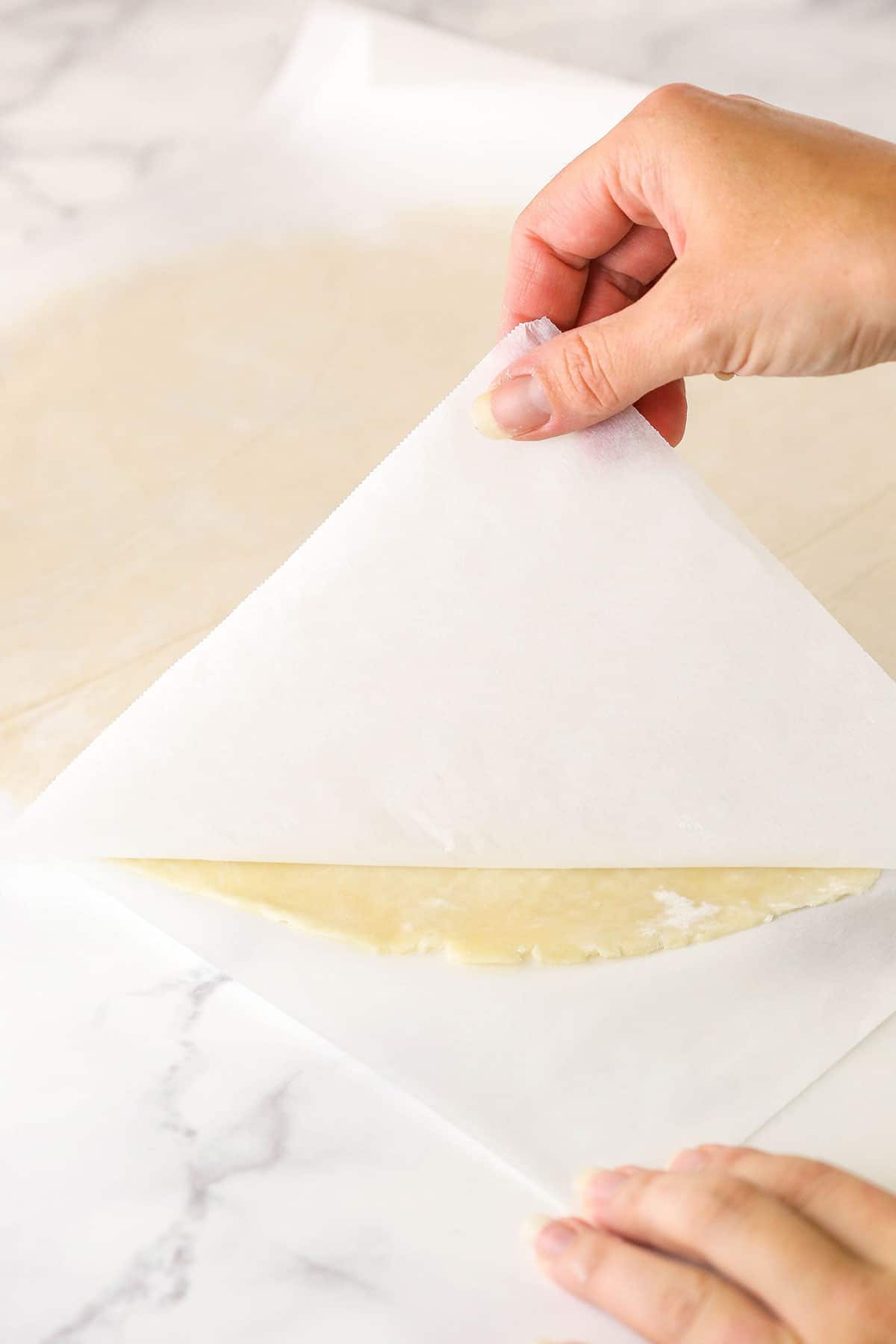
When rolling out the dough, do so gently and start from the center and roll outwards in each direction. You want to roll it out big enough that it’ll fit your pie plate and have some extra around the edges for forming a pretty edge.
After the dough is rolled out, remove the top piece of parchment paper. Then use the bottom piece to move the crust around. Flip it over onto your pie plate, then peel the second piece of parchment paper off.
Trim, flute and beautify your crust as desired. For there, make your pie.
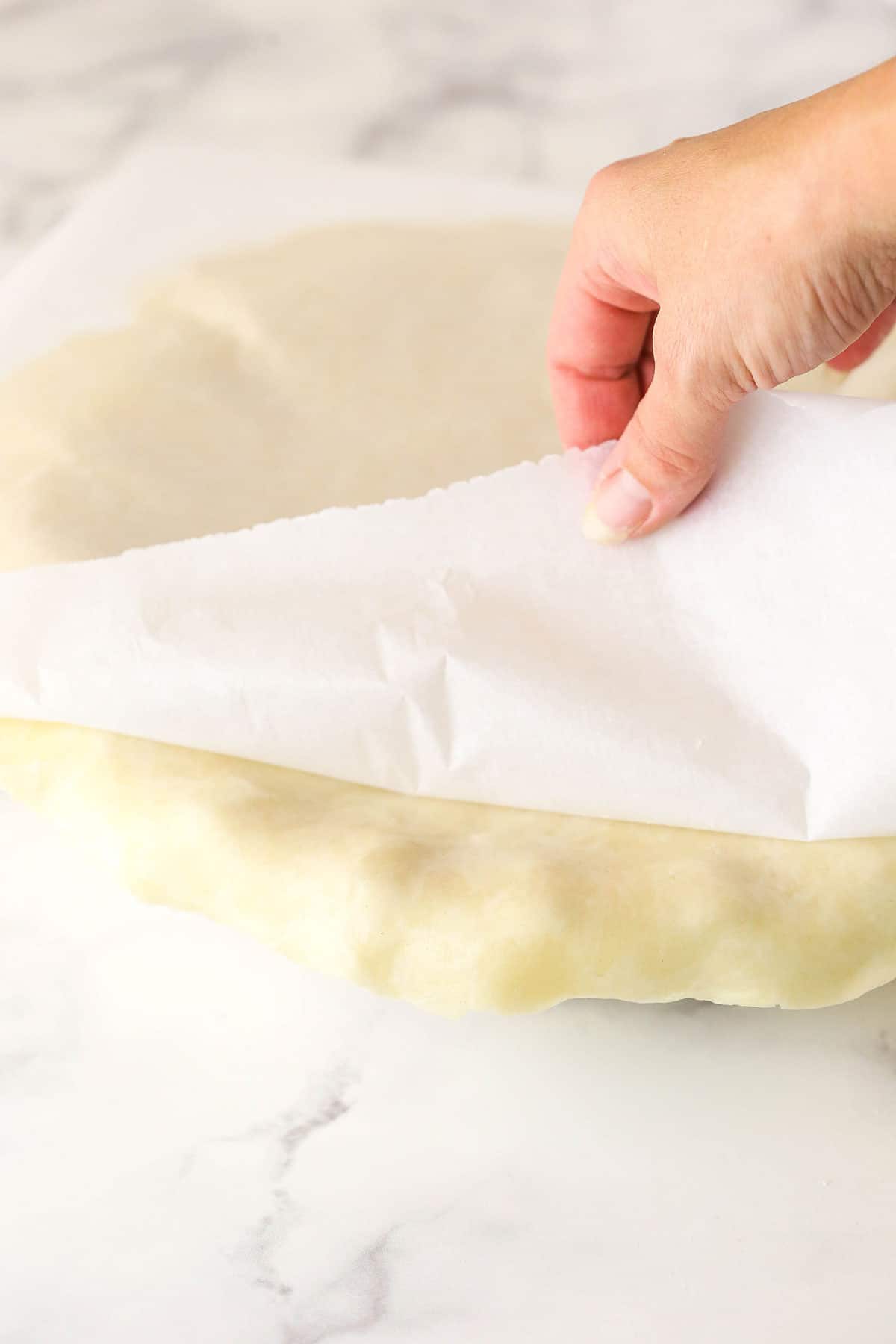
Tips for Success
- Keep Things Cold: You want the butter nice and cold, the water super cold and you want to keep the pie dough cold once make. After you add it to your pie plate, keep it in the fridge until the filling is ready to go.
- Blind Bake: If you want to blind bake your crust, add pie weights and bake at 350 degrees F for 20-25 minutes or until just starting to brown for a partial bake. For a fully baked crust, remove the pie weights just after it starts to brown, then bake for 3-5 more minutes. See my full tutorial for how to blind bake pie crust.
- Pie Weights: These help with blind baking the crust. Without them, the dough will puff up when baked and create issues. There are ceramic balls, single piece metal weights, or you could even use dry rice or beans. I typically add parchment paper underneath my pie weights for easy removal later.
- Pie Crust Shield: This protects the crust from browning too much. This adjustable one is quite helpful.
- Make Ahead: You can make this pie crust up to 2 days ahead of time or freeze it for up to 3 months. Just thaw it overnight in the fridge before using it.
Great Pie Recipes
Now that you know how to make the ultimate crust, it’s time to use on some pies. I have lots of options! Here are some of my favorites.
- Pumpkin Pie
- Salted Honey Pie
- Homemade Apple Pie
- Sugar Cream Pie
- Blueberry Pie
- Sweet Potato Pie
- Classic Pecan Pie
- Strawberry Cream Pie
- Chocolate Pecan Pie
- Cherry Pie
- Caramel Pecan Pie
- Coconut Cream Pie
Watch How to Make Pie Crust
Print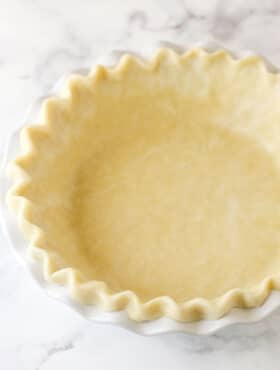
Flaky All-Butter Pie Crust
- Prep Time: 15 minutes
- Chill Time: 1 hour
- Total Time: 1 hour 15 minutes
- Yield: 2 pie crusts
- Category: Dessert
- Cuisine: American
Description
Learn to make the perfect all-butter pie crust with this recipe! The simple method produces a flaky pie crust and can be done with a food processor or by hand! You’ll never need another pie crust recipe!
Ingredients
- 2 1/2 cups (325g) all-purpose flour, divided
- 1 tsp salt
- 1 cup (224g) cold unsalted butter, cut into 1/2-inch cubes
- 1/4–1/2 cup ice water
Instructions
- Add 1 1/2 cups (195g) flour and salt to a large food processor and pulse together 2 to 3 times.
- Scatter the cubed butter over the flour and process until a crumbly dough forms, about 15 seconds. The flour should all be coated – none of the flour should be dry.
- Add the remaining cup of flour and pulse a few times until everything is evenly distributed. The doughy pieces should break up and it should look sandy. There shouldn’t be a bunch of big pieces remaining. A few are fine, but it should be mostly evenly distributed.
- Move the mixture to a medium mixing bowl and add 4 tablespoons of the ice water. Start with 4 tablespoons and add from there. Using a rubber spatula, gently fold everything together. The crumbs should begin to form larger clusters. If you pinch some of the dough and it holds together nicely, it’s ready. If the dough falls apart, add 1-2 more tablespoons of water and continue to press until dough comes together.
- Pour the dough out onto a piece of parchment paper and work just enough for it to come together and form a ball. Cut the ball in half and shape each into a disc.
- Wrap each disc in plastic wrap and refrigerate for at least an hour or up to 2 days.
- When ready to make the crust, place the pie crust onto a piece of parchment paper. You can add a touch of flour if you like, but you don’t have to. Cover the crust with another piece of parchment paper and roll it out with a rolling pin.
- Peel one piece of the parchment paper off and use the other piece of parchment to lift the pie crust and drape it over the pie plate. Carefully peel off the second piece of parchment paper, then shape your pie crust and bake as instructed for your pie.
- Blind Bake: If you want to blind bake your crust, add pie weights and bake at 350 degrees F for 20-25 minutes or until just starting to brown for a partial bake. For a fully baked crust, remove the pie weights just after it starts to brown, then bake for 3-5 more minutes. See my full tutorial for how to blind bake pie crust.
Notes
Pie Weights: These help with blind baking the crust. Without them, the dough will puff up when baked and create issues. There are ceramic balls, single piece metal weights, or you could even use dry rice or beans. I typically add parchment paper underneath my pie weights for easy removal later.
Nutrition
- Serving Size: 1 pie crust
- Calories: 2765
- Sugar: 1 g
- Sodium: 2359.1 mg
- Fat: 187.2 g
- Carbohydrates: 238.6 g
- Protein: 34.2 g
- Cholesterol: 488.1 mg
This recipe modified from Inspired Taste.

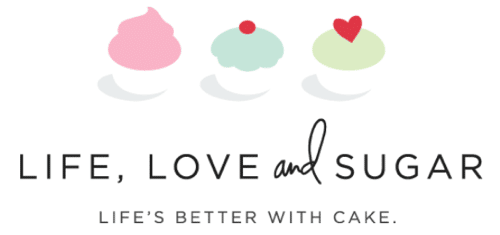
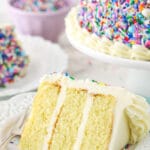
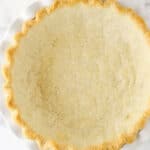

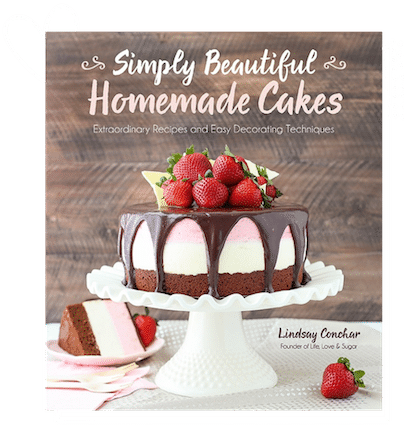
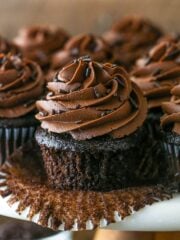
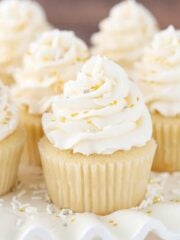
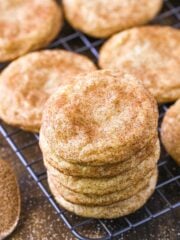
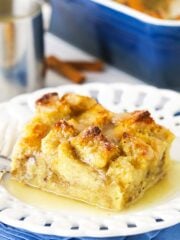

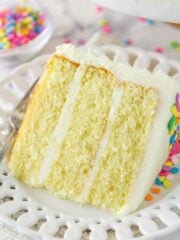
This recipe has won me a baking competition and some mugs. I would really recommend this!
Woot! Congrats on the win! Glad it was a hit!
Hi!, What can I do if I do not have a food processor?
You can still do it by hand. It just takes a little longer and the butter can soften while you’re working with it. I would just chop the butter up as small as makes sense so that you’re not having to spend as long working the flour into the butter.
Can you use salted butter and omit the salt?
Sure, it just might not be the same amount of salt.
Can you use gluten free flour?
I haven’t tried it to be able to say if it has an effect.
A helpful tip that my grandmother is to add 1 TBSP. of white vinegar to the ice water before rolling out the crust. The vinegar bakes out but makes the crust pliable when rolling so that it doesn’t get tough and stays nice and flaky.
Hello Lindsay, Thank you for this recipe. I am wondering if I could use lard and follow the same directions? My daughter is allergic to milk products. Thank you.
I haven’t tried it, but I’d think it’d be fine.
Do you think King Arthur is a good flour and Kerrygold is a good butter for pie crust? Thank you.
Yes, both should be good. I personally use challenge butter.
Does this work well for a pie with a top and bottom crust?
Yes, it should work great.